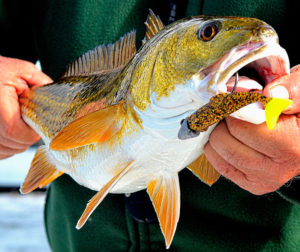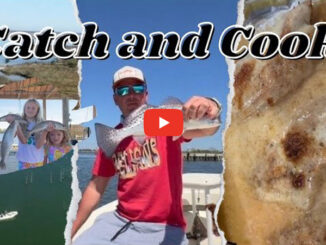
When waters get cold, fishing can get hot south of Dularge. One veteran captain has a handful of strategies for December action.
All has been great with fall fishing for speckled trout and redfish south of Dularge, according to Capt. Bill Lake with Bayou Guide Service.
“Actually, it doesn’t get much better than it has been,” said Lake, 63, a veteran charter captain. “We have been seeing a huge influx of speckled trout in the Dularge area, more fish than we have taken in the last two years.
“And they do have some size to them this year. We are catching many of them in the 14- to 18-inch range.”
These quality trout were taken in late October and the beginning of November, and their appearance has Lake looking forward to fishing in December and January.
Winter patterns
“Our winter patterns here seem to be already starting up,” said Lake (985-637-3712). “We caught 450 trout before the cold front in early November, then the front came in and scattered the trout. But we started finding them again.”
Lake attributed the tendency for the area’s trout to show an early winter pattern to the effects of Tropical Storm Olga.
“With Olga, the saltwater came in and just burnt the grasses in the duck ponds,” he said. “It also killed the roseaus in Sister Lake and Lake Mechant.

According to Lake, the majority of his trout have been caught in canals north of Lake Mechant, areas like Deer Bayou and Trapper’s Bayou.
“There was also a good number of trout moving into Decade in the Eagle Lake area,” he said. “Another place we found trout in November was along the north bank of Lost Lake.
“At the time, there was a lot of shrimp and bird action in these areas. This pattern should remain for the rest of November until we get the strong cold fronts in December.”
December spots, strategies
“The colder it gets, the more speckled trout will move into the deepest waters they can find here,” Lake said. “These can be dead-end canals and deeper natural waterways with at least 6 to 8 feet of water. The natural waterways with a curve into the banks are great, because the trout will stack up in the holes where the waters cut into the banks.”
Lake said anglers will have to use their sonar units because many of the dead-end canals that once held good numbers of trout have silted in and are now 3 feet deep.
“Once anglers find those dead-end canals and natural waterways with sufficient depths, the trout will be stacked up in them,” he said. “Redfish will be in among them, and some great fishing can result.”
In early December, some bird activity will be associated with small shrimp still in the system. Trout may still be found in some of the open lakes, but that activity diminishes with each passing cold front.
“The best way to target these remaining trout under birds is with Vudu shrimp or Berkley Rattle shrimp under 4 Horsemen Corks,” Lake said. “That 4 Horsemen Cork makes a lot of noise to attract trout and redfish.”
By mid-December, Lake said the trout will have moved out of the open waters and will usually push north strictly into the bayous and canals.
“And when it’s cold in December, there is no need to leave the landing early to get to those fish,” he said. “They’ll start feeding after the sun rises between 9 a.m. and 2 p.m., and sometimes we don’t even leave the landing until 9.
“Before that time, you just end up getting very cold and not catching any fish anyway.”
Switching to swimbaits

It’s in the cold winter waters when Lake and his guides switch from using shrimp lures to swimbaits to catch trout and redfish.
“In the bayous and dead-end canals, we’ll cast ¼-ounce swimbaits, Vudu Vixens, Vudu Shads and Tsunami swimbaits,” he said. “When using the Vudu Vixens, we use the gold bunker and the shrimp dip colors. The gold bunker VuDu Shads also work well, and our best colors on the Tsunami swimbait is the golden bunker with spots.
“You want to tight-line these baits and work them slowly on the bottom,” he said. “You have to have more patience fishing slowly, and include a lot of time watching your line. Sometimes, the bite is so subtle that you’ll only see your line suddenly moving, and then it’s time to set the hook.”
Lake said many anglers mistakenly prefer to avoid the cold, thinking that the trout and redfish will fail to bite.
“That’s not the case at all,” Lake said. “Those fish will be hungry, and you can end up catching some good trout in numbers. With each frontal passage however, the trout get real finicky, and you’ll have to give them a day or two to start biting.”
Redfish will be congregated with the trout in the dead-end canals and bayous.
“They’ll stay in deeper waters, like the trout,” he said. “The redfish will be stacked, and they’ll attack the same swimbaits the trout do. You can catch quite a few redfish in those canals when it’s cold and they’re stacked like that.”
Access sites
Falgout Canal Marina is 12 miles down the Bayou Dularge road and offers close access to Lake Decade, Jug Lake and the marshes in the area. At the end of the Bayou Dularge road is Jug’s Boat Launch, which offers the nearest access to Lake Mechant, Sister Lake and Lost Lake.


